- Joined
- Oct 9, 2007
- Messages
- 47,677 (7.43/day)
- Location
- Dublin, Ireland
| System Name | RBMK-1000 |
|---|---|
| Processor | AMD Ryzen 7 5700G |
| Motherboard | Gigabyte B550 AORUS Elite V2 |
| Cooling | DeepCool Gammax L240 V2 |
| Memory | 2x 16GB DDR4-3200 |
| Video Card(s) | Galax RTX 4070 Ti EX |
| Storage | Samsung 990 1TB |
| Display(s) | BenQ 1440p 60 Hz 27-inch |
| Case | Corsair Carbide 100R |
| Audio Device(s) | ASUS SupremeFX S1220A |
| Power Supply | Cooler Master MWE Gold 650W |
| Mouse | ASUS ROG Strix Impact |
| Keyboard | Gamdias Hermes E2 |
| Software | Windows 11 Pro |
BIOSTAR, a leading manufacturer of motherboards, graphics cards, and storage devices today, announces the launch of their new H510 series motherboards designed to run the latest Intel 11th gen Rocket Lake-S processors. Introduced to the market in two Micro-ATX models, the H510MH/E 2.0 and the H510MX/E 2.0 motherboards are designed to be the best choice for business and casual use. Based on Intel's H510 single chip architecture, these motherboards are ready to unleash the true potential of the latest Intel 11th gen processors.
Equipped with all the essential features, the new H510 series comes from an immensely popular lineage of motherboards from BIOSTAR used all over the world in many offices that combine cutting edge technology with proven durability for smart business solutions. Designed to optimize any professional workflow, the H510 series motherboards bring the latest technology for users like PCIe 4.0 and WiFi 6 optimized to perfection with the protection and stability of BIOSTAR's proprietary Super Hyper PWM technology. Both motherboards support dual-channel DDR4 memory, optimized to run up to 64 GB and a maximum clock speed 2933 MHz.
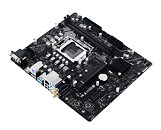
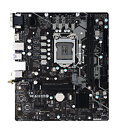
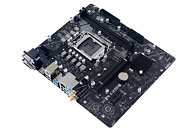
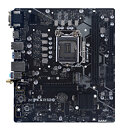
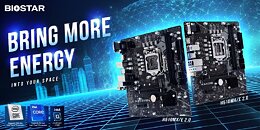
Additional features like Intel GbE LAN and support for USB 3.2 Gen1 makes the H510 series highly efficient and user friendly.
When it comes to rear I/O both motherboards are well thought out, with all the essentials packed in an almost identical layout. H510 series motherboards carry a single PS/2 Keyboard and 1x PS/2 Mouse port specially integrated for users looking to connect an older mouse or keyboard to the system.
2x built-in WiFi antenna ports provide a convenient wireless internet connectivity method. Meanwhile, a single GbE LAN port powered with Intel I219V technology provides more traditional wired network access.
Furthermore, both motherboards come equipped with a single HDMI port and a VGA port. Meanwhile, the H510MX/E 2.0 contains an additional DVI-D port, providing multiple options for display connectivity.
The H510 series motherboards also have 2x USB 3.2 (Gen1) ports, 4x USB 2.0 ports for speedy file transfers. ALC897 chipset powers the 4x Audio output ports provided in both motherboards, capable of outputting 7.1 channels, high definition audio for an immersive user experience.
In Conclusion, if you are a user looking for the best motherboard for business use, the H510MH/E 2.0 and the H510MX/E 2.0 motherboards from BIOSTAR are the best choice in the market. Either a system integration builds to keep your business up to date or for casual content consumption like watching TV shows and movies online such as YouTube or Netflix, the new H510 series motherboards from BIOSTAR is your smart choice.
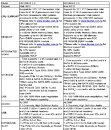
View at TechPowerUp Main Site
Equipped with all the essential features, the new H510 series comes from an immensely popular lineage of motherboards from BIOSTAR used all over the world in many offices that combine cutting edge technology with proven durability for smart business solutions. Designed to optimize any professional workflow, the H510 series motherboards bring the latest technology for users like PCIe 4.0 and WiFi 6 optimized to perfection with the protection and stability of BIOSTAR's proprietary Super Hyper PWM technology. Both motherboards support dual-channel DDR4 memory, optimized to run up to 64 GB and a maximum clock speed 2933 MHz.





Additional features like Intel GbE LAN and support for USB 3.2 Gen1 makes the H510 series highly efficient and user friendly.
When it comes to rear I/O both motherboards are well thought out, with all the essentials packed in an almost identical layout. H510 series motherboards carry a single PS/2 Keyboard and 1x PS/2 Mouse port specially integrated for users looking to connect an older mouse or keyboard to the system.
2x built-in WiFi antenna ports provide a convenient wireless internet connectivity method. Meanwhile, a single GbE LAN port powered with Intel I219V technology provides more traditional wired network access.
Furthermore, both motherboards come equipped with a single HDMI port and a VGA port. Meanwhile, the H510MX/E 2.0 contains an additional DVI-D port, providing multiple options for display connectivity.
The H510 series motherboards also have 2x USB 3.2 (Gen1) ports, 4x USB 2.0 ports for speedy file transfers. ALC897 chipset powers the 4x Audio output ports provided in both motherboards, capable of outputting 7.1 channels, high definition audio for an immersive user experience.
In Conclusion, if you are a user looking for the best motherboard for business use, the H510MH/E 2.0 and the H510MX/E 2.0 motherboards from BIOSTAR are the best choice in the market. Either a system integration builds to keep your business up to date or for casual content consumption like watching TV shows and movies online such as YouTube or Netflix, the new H510 series motherboards from BIOSTAR is your smart choice.

View at TechPowerUp Main Site



